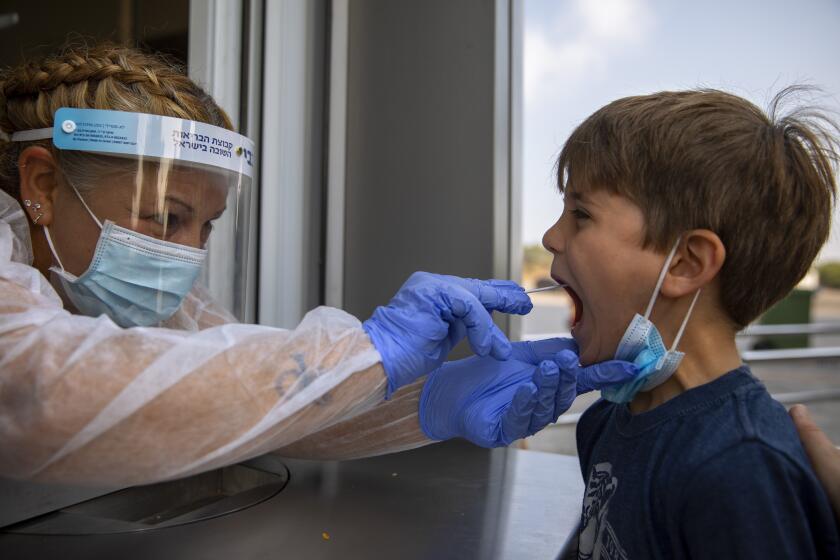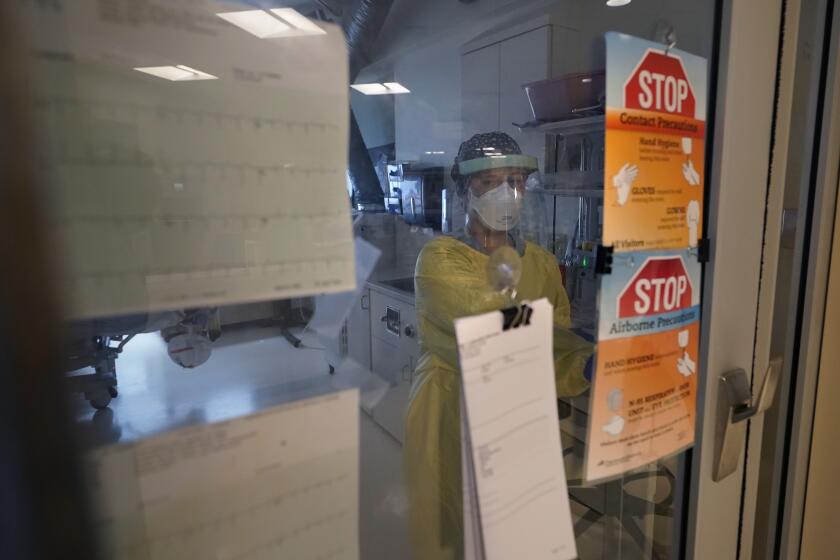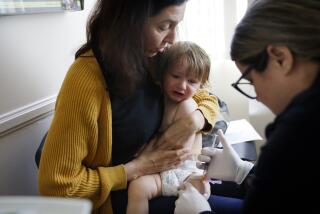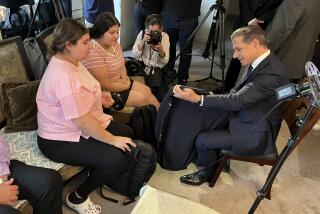‘Don’t panic.’ How parents with kids too young to vaccinate can navigate Omicron

- Share via
As waves of the coronavirus battered the U.S., parents of young kids could comfort themselves with the knowledge that COVID-19 tends to have milder effects in children and that most — but not all — kids who get infected are fine.
But even though it’s low-risk, many parents don’t want to gamble with their kids’ health. And others might be more worried that their kids will spread COVID-19 to elderly or immunocompromised loved ones who might not fare as well.
Now the highly contagious Omicron variant is sending case counts through the roof, and most young kids are not yet vaccinated. Children under 5 are still ineligible for vaccinations, and as of Dec. 29, only 23% of kids 5 to 11, and 53% of 12- to 17-year-olds, are fully inoculated in the United States.
With so many unknowns, how do we balance protecting our families and retaining a sense of normalcy?
We asked experts how parents of unvaccinated children should navigate the Omicron surge. They acknowledged that it’s a tough situation and emphasized that many of these decisions will differ based on each family’s vulnerability and risk tolerance. Here’s what they advise.
What is the timeline for kids under 5 to get a COVID vaccine? Here’s the latest.
What has changed with Omicron?
Omicron is much more infectious than previous variants, but so far seems to be less severe. “The numbers of cases are just so high, really everywhere,” said Tara Kirk Sell, a senior scholar at the Johns Hopkins Center for Health Security. “And if they’re not high yet, they will be high. It’s incredibly transmissible.”
As a result, more children are being hospitalized with COVID-19. However, experts believe the increase correlates with the skyrocketing number of people getting infected, not the severity of disease the variant causes in kids.
This follows the natural progression of viruses, explained Dr. Catherine Le, an infectious disease physician at Cedars-Sinai Medical Center. Viruses mutate in order to survive, but they won’t survive if they kill off their hosts. So over time, they generally evolve to be more infectious but less dangerous.
Symptoms with Omicron could be slightly different. “These are early days in the Omicron pandemic, but it seems like we are seeing more upper respiratory tract symptoms, including croup in children,” said Dr. Grace M. Aldrovandi, professor and chief of infectious diseases at UCLA Mattel Children’s Hospital. “Generally, symptoms in children are less severe than in adults, and they may have more gastrointestinal symptoms, compared to adults with COVID.”
Dr. Priya Soni, a pediatric infectious disease specialist at Cedars-Sinai Medical Center, said Omicron symptoms tend to include fevers, dry cough, sore throat, body aches and night sweats. “Those are really hard to denote in young kids though,” she said. “So mostly, I’m seeing high fever and kids that have a runny nose.”
There’s more we don’t know. With kids, “we’re talking about a group that perhaps may not be at a higher risk, but to tell you the truth, the jury is out,” said Dr. Neha Nanda, medical director of infection prevention and antimicrobial stewardship at Keck Medicine of USC.
For example, a report from the Centers for Disease Control and Prevention showed that children with COVID-19 could be twice as likely to be diagnosed with diabetes after a coronavirus infection, compared to those who had not had the virus.
We also don’t know whether it’s associated with multisystem inflammatory syndrome in children, known as MIS-C, which is “rare, but scary,” Le said, because it can result in organ failure weeks after a coronavirus infection.
It’s also too early for there to be data on whether Omicron leads to long COVID in kids. A national survey in England found that up to 14% of kids with COVID-19 prior to Omicron’s emergence had continued symptoms more than 12 weeks after diagnosis.
“Those kids had impacts in fatigue, headache, insomnia, trouble concentrating, and it really, really limited their quality of life and participation in school,” Soni said.
The apparently milder Omicron variant has some parents thinking it might be helpful to let their kids get infected. But experts say there’s no upside.
What hasn’t changed?
All the protective measures we’ve taken since the beginning of the pandemic are still important now. When there is less COVID-19 in the community, there is less risk and more room for relaxation, but the surge is a good time to ramp up your masking, social distancing, hand-washing and other safety protocols, experts say.
This is true specifically for kids because if they are hanging out with other children — for example, at school or day care — there’s a high probability that they’re hanging out with kids who aren’t vaccinated.
Which kids are most vulnerable?
“Children less than a year of age, those with chronic illnesses — neurologic, immunologic or respiratory conditions — and those who are obese have a higher risk of becoming very ill with the SARS-CoV-2 illness,” Aldrovandi said.
These include children who have a history of leukemia, are getting chemotherapy or are transplant recipients, Soni said.
Dr. Kawsar R. Talaat, associate professor of international health at the Johns Hopkins Bloomberg School of Public Health, encouraged worried parents to talk to their pediatrician. “There are some kids who maybe should be kept at home and protected from others until the surge resolves,” she said. “It’s a very individual conversation between the parents and the doctors: what their risks are and how to best protect their kids.”
Hospitalizations of U.S. children under 5 with COVID-19 have soared, a worrisome trend in youngsters too young to be vaccinated.
What can concerned parents do?
Make sure everyone around your kids who is eligible is vaccinated and boosted. If you have a get-together, it’s less risky if all the adults around them are masked, vaccinated and boosted. This creates a protective cocoon around them, Talaat said. If you send your kids to day care, it’s important to know that the employees are vaccinated, boosted and masked — and that if they get sick, they don’t have to come to work.
Having a support system of people who are vaccinated and boosted also means you might have help in case you test positive and want to isolate from your kids, said Kirk Sell, who encourages parents to make plans for various possible scenarios.
Mask up, even when outside. “We now recommend that children, even as they’re going back to school, remain masked in heavily populated outdoor spaces,” Soni said.
This includes playgrounds, where there are lots of kids in the same area.
Parents should also move toward better quality masks for kids — such as surgical masks or KN95s — if they haven’t already, Aldrovandi said. She recommends the website cleanaircrew.org/kids-masks as a resource.
Experts don’t recommend masks for children under 2 because of the risk of suffocation, so parents of kids in that age group might choose to socially distance more, depending on their comfort level.
Avoid crowds of people. Suellen Hopfer, an assistant professor of public health at UC Irvine, recommended avoiding places where there are a lot of people gathered, especially indoors. She also recommended deferring travel plans.
Get kids tested. Kids get many colds, so it’s important to test when they have symptoms to see if it’s COVID-19, Soni said.
Testing in children is generally the same as adults, but the challenge is to get the child to cooperate. “Even before COVID, we would perform nasopharyngeal swabs in children, including babies, to diagnose respiratory viral infections,” Aldrovandi said. “The virus is the same in children and adults, so rapid tests can be used in children.”
Testing sites can vary in terms of safety, she said. “This virus is spread through the air so it is important to go to a testing site with good ventilation — outside or in your car — [and where] people are wearing high-quality masks and kept distanced.”
Your pediatrician’s office should also be able to test.
When they are eligible, get them vaccinated. Because COVID-19 is unpredictable, experts urge parents to vaccinate their kids. A Moderna pediatric COVID-19 vaccine for children 6 months to 5 years old could be authorized in late March or early April, and Pfizer and BioNTech are expected to submit data to regulators to support authorization of their vaccine in the first half of the year.
“You’re preventing the possibility of long COVID and MIS-C,” Soni said. “We should feel very confident in the safety of this vaccine to be giving it to these kids in this age.”
Also, you’re making it less likely your kid could spread the coronavirus. “It just makes you a lot less worried about it,” Kirk Sell said.
Try to stay calm “Parents’ anxiety can be sensed by young children,” Aldrovandi said. “It is important that parents try and model how to react to stressful situations. Parents should try to decrease their own anxiety by staying focused on the present and not be overly concerned about worst-case scenarios. Establishing routines can help both parent and child.”
“There’s no zero-risk scenario,” Kirk Sell said. Instead, she said, it’s about having low risk and a life that works for you.
All these experts reiterated that most kids, if they get infected with the coronavirus — Omicron or otherwise — will be OK. “We hope that they won’t have to experience it,” Talaat said. “But don’t panic.”










